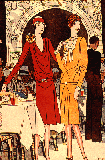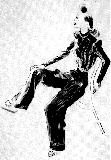


This was a period of immense social upheaval, particularly for women. The period
from 1911 to 1919 saw the crescendo of the Women's movement, culminating in
the passage of the Suffrage amendment. This was also the decade of World War
I,  which
both shook apart the previous social order, and also called upon women to step
into roles never before filled by women, as men went off to war. After the war,
there was an explosion of exhuberance in style, as a youthful generation took
center stage amid a decade of prosperity. The excitement of
Jazz
Age life, prohibition, and the idealization of college men and coeds in
the US gave a youthful emphasis to fashion.
which
both shook apart the previous social order, and also called upon women to step
into roles never before filled by women, as men went off to war. After the war,
there was an explosion of exhuberance in style, as a youthful generation took
center stage amid a decade of prosperity. The excitement of
Jazz
Age life, prohibition, and the idealization of college men and coeds in
the US gave a youthful emphasis to fashion.
Between 1911 and 1919, dress forms moved to a narrow, relaxed, almost semi-fitted
silhouette reminiscent of the Directoire and Empire period. Although many women continued the habit of
wearing corsets, the tubular clothing silhouette no longer required it. Hemlines also began to climb from ankle
length in 1910 (right) to mid-calf by 1919 (left)-- and all the way up to the knee by 1925. The waistline
essentially disappeared.
Before 1919, it was high, just below the bustline;
by 1920 it had
settled at the hips.
 The silhouette was basically tubular throughout the period. However, this was
also a period of great experimentation in fashion--the first time in centuries
that designers had a truly different silhouette to work with. Innovative seaming,
draping, gauzy fabrics, beads, and feathers were all called upon. In this example
(right) from the mid-1920s the use of seaming as a decorative detail can be
seen.This love of surface embellishment and abstract, graphic design is a general
characteristic of art deco design in other media as well. Menswear concepts
were used also, including a number of sportswear ideas, such as the sweater.
Knits, leather, and rayon for the first time became important fashion materials.
Poiret
and Fortuny were among the
most well-known designers of the period before World War I. Designers such as
Chanel and
Patou were trend setters in the 1920s.
The silhouette was basically tubular throughout the period. However, this was
also a period of great experimentation in fashion--the first time in centuries
that designers had a truly different silhouette to work with. Innovative seaming,
draping, gauzy fabrics, beads, and feathers were all called upon. In this example
(right) from the mid-1920s the use of seaming as a decorative detail can be
seen.This love of surface embellishment and abstract, graphic design is a general
characteristic of art deco design in other media as well. Menswear concepts
were used also, including a number of sportswear ideas, such as the sweater.
Knits, leather, and rayon for the first time became important fashion materials.
Poiret
and Fortuny were among the
most well-known designers of the period before World War I. Designers such as
Chanel and
Patou were trend setters in the 1920s.
During the depression years of the 1930's fashion was driven by the fantasies
of Hollywood, and by a desire to return to a more traditionally feminine image
for women, 
 as women were forced by economics to return to a more traditional life. In the
face of mass unemployment, it was generally felt that women should leave the
workplace to men-- at least until the outbreak of World War II in 1941. During
the early 1930s hemlines dropped again to just above the ankles, and longer
dresses were again in vogue for evening wear (right). The tricks of draping
and intricate seaming learned in the 1920s were now applied to making dresses
that clung to the body. Soft crepe, chiffon, and satin cut on the bias were
used. For evening the bared back was the new erotic zone, replacing the legs
of the 1920s. As the decade advanced, hemlines would rise again. The shirt dress
(left) was a new style introduced in this period that would become a classic.
Vionnet and
Schiaparelli
were among the leading designers.
as women were forced by economics to return to a more traditional life. In the
face of mass unemployment, it was generally felt that women should leave the
workplace to men-- at least until the outbreak of World War II in 1941. During
the early 1930s hemlines dropped again to just above the ankles, and longer
dresses were again in vogue for evening wear (right). The tricks of draping
and intricate seaming learned in the 1920s were now applied to making dresses
that clung to the body. Soft crepe, chiffon, and satin cut on the bias were
used. For evening the bared back was the new erotic zone, replacing the legs
of the 1920s. As the decade advanced, hemlines would rise again. The shirt dress
(left) was a new style introduced in this period that would become a classic.
Vionnet and
Schiaparelli
were among the leading designers.

 In this period movie stars like
Marlene Dietrich and
Katherine Hepburn made it acceptable for women to wear trousers in public
(below, right). With the outbreak of World War II, as women were being encouraged
to replace men in the factories and offices, clothing generally became more
tailored, and frequently borrowed from military looks-- even to prominent, padded
square shoulders (left). Wartime shortages led to official directives to keep
dresses narrow and short, without extra draping and excessive use of fabric.
Since clothing was rationed, accessories became important as a way of varying
a limited wardrobe. The war also provided an opportunity for American designers
to establish themselves; previously fashion ideas had emanated mainly from Paris.
In this period movie stars like
Marlene Dietrich and
Katherine Hepburn made it acceptable for women to wear trousers in public
(below, right). With the outbreak of World War II, as women were being encouraged
to replace men in the factories and offices, clothing generally became more
tailored, and frequently borrowed from military looks-- even to prominent, padded
square shoulders (left). Wartime shortages led to official directives to keep
dresses narrow and short, without extra draping and excessive use of fabric.
Since clothing was rationed, accessories became important as a way of varying
a limited wardrobe. The war also provided an opportunity for American designers
to establish themselves; previously fashion ideas had emanated mainly from Paris.

After the hardships of the War, soldiers returned to take up careers and marry, and
women were expected to give up their wartime careers to become homemakers and mothers. Again, with this new domesticity,
there was a move toward a more feminine look. There was also a desire to indulge a yen for
luxury, after the years of deprivation and rationing.

 The French designer Christian Dior, in a move to fulfill this yen (and re-establish
the French fashion industry) introduced the New Look in 1946. It featured long
hemlines, narrow shoulders and closely fitted bodices, and full, crinolined
skirts (Above, and right). In many ways, this look resembled the fashions of
the Early Victorian era, which was also a period that focused on domesticity.
Dior subsequently introduced a narrow long skirt, which gave a figure revealing
silhouette not unlike that of 1880. The New Look also required a kind of corseting,
in the form of the two-way stretch "merry
widow" and matching girdle. Charles James was another designer that contributed
innovative ideas in this period. Among the ideals of feminine beauty and style
in this period were Marilyn
Monroe and
Doris
Day.
The French designer Christian Dior, in a move to fulfill this yen (and re-establish
the French fashion industry) introduced the New Look in 1946. It featured long
hemlines, narrow shoulders and closely fitted bodices, and full, crinolined
skirts (Above, and right). In many ways, this look resembled the fashions of
the Early Victorian era, which was also a period that focused on domesticity.
Dior subsequently introduced a narrow long skirt, which gave a figure revealing
silhouette not unlike that of 1880. The New Look also required a kind of corseting,
in the form of the two-way stretch "merry
widow" and matching girdle. Charles James was another designer that contributed
innovative ideas in this period. Among the ideals of feminine beauty and style
in this period were Marilyn
Monroe and
Doris
Day.


In 1955 Dior suddenly died, leaving his empire to a 21 year old assistant named Yves St.
Laurent. St. Laurent proceeded to introduce a series of innovations in
silhouette that established him as the trend setter for years to come. In this period, he
experimented with less closely fitted styles, using materials that permitted him to
sculpt shapes that stood away from the body.
On the whole, the silhouette was generally more tubular than it had been. Other influential designers in this period were Givenchy, Claire McCardell and Bonnie Cashin. However,
glamorous images devised by the media and the fashion designer still characterized the ideal
female image.
Among the ideals of the fashionable woman in this period were Audrey Hepburn
and Jacqueline
Kennedy.
 |